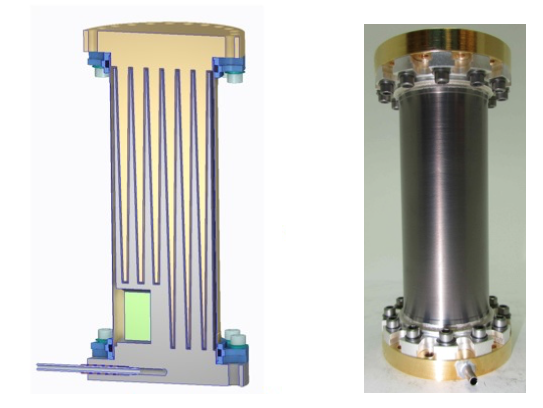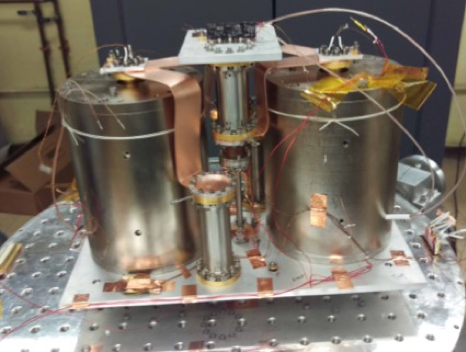6 min read
PROJECT
High-Efficiency Continuous Cooling for Cryogenic Instruments
SNAPSHOT
To cool proposed future science instruments to operating temperatures well below one Kelvin, NASA is developing an advanced spaceflight magnetic refrigeration system.

Several proposed future space-science instruments will operate at temperatures well below one Kelvin to enable high-sensitivity astronomical measurements. Magnetic refrigerators have been used to reach these temperatures on past space missions. As space-science detector technology matures and array size (similar to pixels on a camera) grows larger, future instruments will need higher cooling power at even lower temperatures. NASA is developing an advanced multi-stage magnetic cooling system to meet these needs.
Many astrophysics instruments, particularly those operating in the X-ray and infrared spectral ranges, can achieve maximum sensitivity by maintaining their detectors at temperatures close to absolute zero. However, conventional spaceflight refrigerators are unable to cool below about one Kelvin. To reach the required lower temperatures in space, NASA developed magnetic cooling systems many years ago. These devices, known as adiabatic demagnetization refrigerators (ADRs), use specially chosen paramagnetic materials that can be heated or cooled by increasing or decreasing a magnetic field surrounding them. Having no moving parts, they operate reliably and efficiently and produce no mechanical vibrations. A single ADR stage includes a paramagnetic refrigerant “pill,” which is suspended inside a superconducting electromagnet. One side of the pill is thermally linked to the instrument, and its other side is connected to a cold sink via a heat switch, which controls heat flow in a similar way to a light switch controlling electrical current. The cold sink is typically a commercial 4 Kelvin mechanical cryocooler or a 1.2 Kelvin liquid helium tank.

The ADR stage’s cooling cycle begins by closing the heat switch and rapidly increasing the magnetic field to its maximum value. The pill temperature rises slightly above that of the heat sink, causing heat to flow through the switch to the sink. Then the switch is opened, and the magnetic field is rapidly decreased. The pill cools to its operating temperature, which is typically about 0.05 Kelvin. Now the instrument can collect science data, as its temperature is held constant by a feedback-loop which slowly ramps down the magnetic field until it reaches zero. At this point the instrument’s sensing temporarily ends, and the ADR is re-cycled. The length of time during which the instrument is held at its operating temperature depends on how much heat it generates. The first spaceflight ADR, built by NASA for the Astro-E2 mission and launched in 2005, cooled to 0.06 Kelvin from a 1.2 Kelvin sink and allowed the detectors to operate for nearly 40 hours between one-hour recycling events.
A more efficient system results from operating multiple ADR stages in series, separated by heat switches. The stages are demagnetized in a cascade scheme, with each one pre-cooling the remaining stages before they are brought to much lower temperatures. The ASTRO-H mission, launched in February 2016, included a two-stage NASA-built ADR that cooled from a 2 Kelvin sink to 0.05 Kelvin and weighed much less than the ASTRO-E ADR. The ASTRO-H ADR held its operating temperature for 48 hours during each cycle.
The most efficient multi-stage ADR scheme turns out to be one in which a single stage is held continuously at the operating temperature, and the other stages pass heat to each other in “bucket brigade” fashion, finally passing it to the sink. The Cryogenics branch at NASA Goddard Space Flight Center perfected a laboratory version of this Continuous ADR (CADR) more than ten years ago, and they have since duplicated it for both lab use and for a balloon mission. This four-stage system cools to 0.05 Kelvin from a 3 Kelvin sink, absorbs 15 times more heat than the ASTRO-H two-stage ADR, and weighs significantly less. In addition, the 0.05 Kelvin continuous stage never needs to be recycled, so scientific measurements remain uninterrupted.

Since 2017, the Goddard team has been working to upgrade the laboratory CADR design so that it can survive a launch into space. Extensive structural analysis was performed to determine whether any components needed additional strength or stiffness. The most challenging aspect of the re-design effort has been the assemblies which hold the pills inside the magnets. Each suspension system, made with multiple tensioned Kevlar strings, must be very strong and stiff while keeping the pills thermally isolated from their surroundings. To survive a space launch, thicker Kevlar strings were needed, so their length had to be increased to avoid excessive heat flow into the pills. This led to redesign or relocation of nearby components, which would otherwise have interfered with the strings.
In addition, the CADR has two new stages which allow it to operate with a 10 Kelvin sink. This new design may enable future missions to couple an ADR to a new type of cryocooler that produces essentially zero mechanical vibrations. Concept missions such as the Large Ultraviolet Optical Infrared Surveyor (LUVOIR), with extremely tight stability requirements, may be candidates for this option. The Goddard team recently completed the two-stage part of the CADR that cools from 10 to 4 Kelvin and began testing it.

To fully qualify the design upgrades, an entire flight-worthy prototype CADR system must be built. A significant challenge faced by the Goddard team has been to accomplish this in parallel with a spaceflight mission, which is also producing a multi-stage ADR. Competition for specialized in-house Goddard resources has forced the CADR team to find and cultivate relationships with commercial shops. Although it delayed some work in the short term, expanding the source options for specialized machining and processing will be a benefit to future CADR campaigns.
The new advanced CADR will be enabling technology for several prospective future mission concepts. Two different instruments on Origins Space Telescope, as well as Lynx, the Probe of Inflation and Cosmic Origins, and the Galaxy Evolution Probe have all baselined the CADR to provide sub-Kelvin cooling. In addition to demonstrating the CADR’s cooling capability and robustness, the Goddard effort is training experts and a new generation of engineers to build and test the flight systems for these projects in the future.
PROJECT LEAD
Dr. Jim Tuttle, NASA Goddard Space Flight Center
SPONSORING ORGANIZATIONS
Astrophysics Division, Cosmic Origins Program







